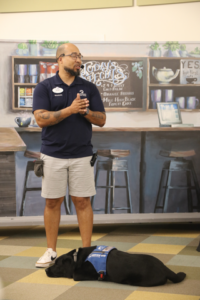 This story is about Green Beans, a veteran, his family, and a dog, or dogs, to be more precise. But the story starts in the desert warzone of Iraq with Soldier Sean Brown. Sean joined the U.S. Army in 2006 and served in the Intelligence and Quartermaster Corps. Sean had followed in his parents’ footsteps, both of whom had served: his dad for 28 years and his mom for 14 years.
This story is about Green Beans, a veteran, his family, and a dog, or dogs, to be more precise. But the story starts in the desert warzone of Iraq with Soldier Sean Brown. Sean joined the U.S. Army in 2006 and served in the Intelligence and Quartermaster Corps. Sean had followed in his parents’ footsteps, both of whom had served: his dad for 28 years and his mom for 14 years.
The U.S. Army eventually sent Sean to Iraq three times, where some bad things happened, causing Sean’s medical retirement in 2013. Like many service members, Sean had a story about the bad thing, but he kept that story inside, leading to recklessness and indulgence. Life seemed to take some dark turns after service. Sean was living in Savannah, where “everyone loves their troops,” Sean says, “but where no one would hire me because I would wake up in the morning with no feeling in my legs.” Sean worked four or five part-time jobs to keep the lights on and the bills paid. At the end of the day, “I was struggling just to find life, to find success.” Sean had a TBI (Traumatic Brain Injury), a dead spot on the left side of his brain. He had been through more than nine surgeries on his left knee, including total knee replacement, and he suffered from a degeneration of the spine. Waking up and starting the day was physically difficult; in addition to that, loss of purpose and hope can be dangerous.
An adrenaline rush is addictive, and sometimes, Sean finds himself on a motorcycle he can ride fast and recklessly to feel alive again. Sean found a camaraderie he had been missing with a motorcycle group in Savannah. “We rode a lot, partied a lot, and mostly all suffered from PTSD,” explains Sean. Sean’s Harley Davidson had become his outlet and tool for escape, but it was only a matter of time. “With the injuries I have, I knew it was a ticking time bomb. I knew my leg would ultimately give out. I just waited each day for it to happen.” One day, Sean stopped at a stoplight while on his Harley, and his left knee gave out. The bike was falling, and he couldn’t stop it. “I had to decide to put away the bike before I hurt myself or somebody else,” he laments.
Sean had met the woman he would marry after his medical discharge from service. With many military spouses, she rode the waves of emotion alongside her husband with every challenge, disappointment, and loss. His attempts to feel better, both physically and emotionally, depended on a massive number of pills prescribed by his doctors. He was filled with hostility and anger, most of which he kept from his wife until the green beans.
It was a day like any other, and Sean had prepared dinner for his wife, who was pregnant then. The meal he prepared included green beans; his wife liked green beans. However, she had read that green beans were unhealthy while pregnant, so she chose not to eat them. Something at that moment, in that simple event, triggered Sean, who flew into a rage, pounding a hole into a wall of their home. He loved his wife and would never hurt her, but the bottled-up emotions were just too much to hold back. Sean says, “My wife turned to me and said, Sean, you need help.” Sean admits with a grin, “Happy Spouse, Happy House – Happy Wife, Happy Life.” The two began researching available programs for veterans.
It wasn’t long before they realized that a service dog was the answer. The first few organizations they approached required thousands of dollars to get a dog. Then they found Southeastern Guide Dogs where, if Sean qualified, he could get a dog for zero dollars, yes, zero! Sean put in his application. “I was coming out of a pretty bad appointment at the VA when I received the call that there was a dog for me, and my life changed forever.”
Pella, the angel with four legs and a tail.
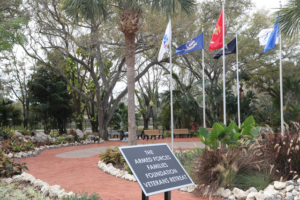 On the Southeastern Guide Dogs Campus, there are many buildings. During our visit to the SGD Campus, we took a tour of the entire facility. Sean shared each and every aspect of the Campus, as well as exciting future plans for the organization to grow its service dog footprint. When we reached the guest rooms, he smiled a big smile and pointed to the chair where he met Pella.
On the Southeastern Guide Dogs Campus, there are many buildings. During our visit to the SGD Campus, we took a tour of the entire facility. Sean shared each and every aspect of the Campus, as well as exciting future plans for the organization to grow its service dog footprint. When we reached the guest rooms, he smiled a big smile and pointed to the chair where he met Pella.
The joy in his memory spread to all of us in the room, and we learned about the incredible, happy, and life-changing moments in these comfy chairs.
“Pella knew when I was upset or anxious, she would immediately come to me and calm me down. I had spent so many years behind a mask, pretending to be okay, but I didn’t have to lie or hide from Pella; she just knew.” The other thing that Sean had been dealing with, and his family alongside him, was his avoidance of anywhere public. “I didn’t like to be in crowded places and would avoid going to restaurants and stores; now, with Pella, I know she has my back.” Sean and Pella knew what each other was thinking as their relationship grew. “Pella had a command that she would do without me having to say a word. It was ‘find the door’. She could sense a large crowd; if it was too compacted and too much for me, she would pull on the leash and drag me to the nearest door,” he recalls.
After several years, Pella let Sean know that she was done working. “There is a way to tell when a service dog needs to retire. Pella had acquired a reaction to noise, which was a clear sign she was tired and ready to enjoy retirement.” The service dogs must retire before age 11, but SGD performs annual follow-ups with the dog and its person to ensure everything is good. Sean didn’t waste any time and quickly applied for his successor dog and was happily paired with Nick. “We all live happily together. There is Pella, Nick, and another small puppy we are raising. My dogs love to watch Forest Gump. When Tom Hanks comes on, and that feather starts falling from the top of the screen, it’s a wrap.”
The Campus History
Everything started in a small farmhouse with three dogs and a station wagon in 1982. Within the last six years, the Campus has been built with completely paid-for buildings that are all category four hurricane-rated. The entire Campus sits on 33- acres of land in Palmetto, Florida. Recently, SGD acquired 30+ neighboring acres that will be used for growth expansion. Sean credits SGD CEO Titus Herman, who ensures all programs and infrastructure are paid for before construction or implementation. “We don’t start a project unless it is completely funded. This allows us to put 100% of our proceeds towards the mission,” he explains.
Southeastern Guide Dogs began as a Guide Dog center for the visually impaired. Sean recalls Michael Jernigan, one of the first veterans to get a Southeastern Guide Dogs Dog. He was the first post-9/11 injured Marine with visual impairment who had come through the program. We realized that our dog was helping him to mitigate PTSD, thus becoming the cornerstone of our service dog program.
The Puppy Academy
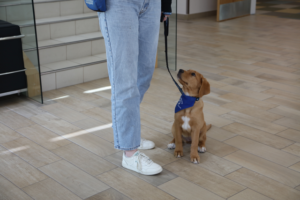 The Puppy Academy building has 12 wings. The mom dogs come here for labor and delivery and are treated to aroma therapy, acupuncture, massage therapy, music therapy, and more. Sean points us to a wall of thick windows where we can peak in on newborns, just like in a human hospital nursery, minus the little cribs. Sean explains that many puppies are born at night, so someone is always on watch at the Puppy Academy.
The Puppy Academy building has 12 wings. The mom dogs come here for labor and delivery and are treated to aroma therapy, acupuncture, massage therapy, music therapy, and more. Sean points us to a wall of thick windows where we can peak in on newborns, just like in a human hospital nursery, minus the little cribs. Sean explains that many puppies are born at night, so someone is always on watch at the Puppy Academy.
Rewind – Before the Puppy
There is care and incredible science that goes into the breeding of these exceptional dogs. SGD uses a breeding cooperative, a natural program where two dogs are paired and allowed to mate. “There is a honeymoon suite in the back,” explains Sean, “We match up two dogs, play a little music, and voila.” In my mind, I am imagining the scene from Lady and the Tramp with the spaghetti.
SGD has relationships with other guide dog schools nationwide to remain biodiverse and genetically diverse. The key is to have the most healthy temperament dogs. The science behind SGD has managed to breed hip dysplasia down to 3% of its Labrador Retrievers when 30% of all labs typically suffer from the disease.
Puppy Kindergarten & Pre-K Enrichment and Education
The newborn pups will stay with their moms for the first six to eight weeks of life. During that time, Mom gets breaks, including spa days. The puppies have a daily training plan. They practice ‘dress up’ for their harnesses and noise reactions to vacuums, and they are taught to look up and see things above their heads. If there is a dog with special educational needs, they implement protocols for them to learn and excel. Service dogs and guide dogs must have confidence, thus becoming a highly targeted trait.
Pre-K starts at two days old in a room full of novel objects and training tools.
The Campus
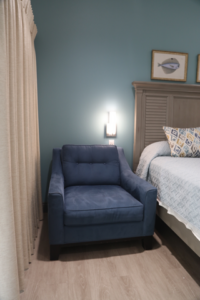 The Puppy Academy includes an operating clinic for X-ray machines, Estrogen Machines, and Cryo-Chambers for stored semen, called ‘sperm vision.’ There is a canine Ophthalmologist on site and just about any other medical service you can imagine.
The Puppy Academy includes an operating clinic for X-ray machines, Estrogen Machines, and Cryo-Chambers for stored semen, called ‘sperm vision.’ There is a canine Ophthalmologist on site and just about any other medical service you can imagine.
A canine fitness center is complete with a splash park for pool parties. The fitness center has essential training tools, such as a room with airline seats so dogs can be trained to operate on an airline, on buses, and in other tight places.
The Canine University is an X-Wing building that houses the class-ready dogs. Each wing of the building is for the Freshman, Sophomore, Junior, or Senior class dogs. They have roommates and dorm parties; Sean says, “They have a blast!” Sean points out the silence around the building and lets us know that the dogs inside the university have been trained not to bark. “It is called the quiet protocol. They know they won’t get a treat if they are barking,” explains Sean.
A Grand Reopening, hosted by the Armed Forces Family Foundation, was celebrated in 2023 for an outdoor area named The Veterans Courtyard. It is a place where attending veterans can come out and relax, have fun, and connect with each other.
In addition to the significant buildings and amenities for the guide and service dogs, the Campus has a fully functional student center and dormitory, including a gym, lounge areas, laundry facilities, and computer rooms for its guests.
Sean’s Journey
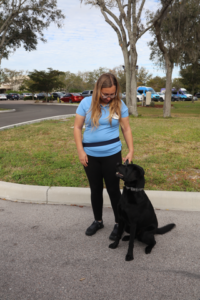 When Sean received his dog, his family also decided to move to Florida after Sean was offered a position at Southeastern Guide Dogs. He is currently the acting Associate Director of Philanthropy for the organization. Sean spends three to four days a week on Campus, and he has the flexibility to work remotely when he needs to.
When Sean received his dog, his family also decided to move to Florida after Sean was offered a position at Southeastern Guide Dogs. He is currently the acting Associate Director of Philanthropy for the organization. Sean spends three to four days a week on Campus, and he has the flexibility to work remotely when he needs to.
“One of the things we talk about in the military is taking care of the troops. We take care of each other. I get to do that again, working here at Southeastern Guide Dogs.” Sean has found a place and a purpose at SGD in his five years with the organization. He remembers where he was before Pella, “It’s rare as a veteran that lives with what I’ve lived through, the pain that I live with daily, to be able to sit down on most days and say, I’m okay. I’m home. I’m making progress.”
There is so much more to this story. We encourage you to watch for an expanded feature in an upcoming edition of FireWatch Magazine. As for Sean, he continues to witness the changing of lives with Nick by his side, and for him, that is a good thing.